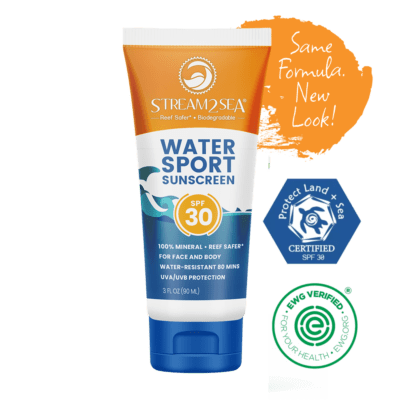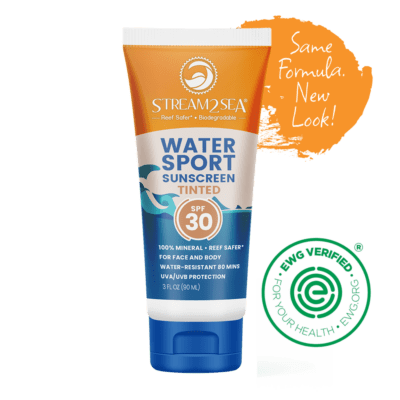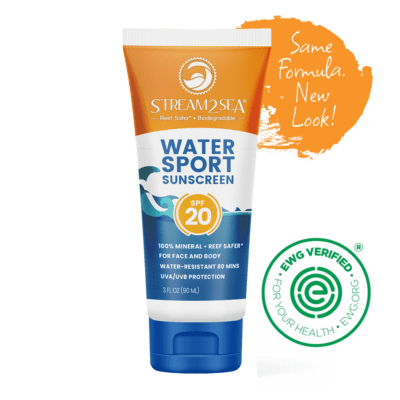Following a new study released on January 28, 2020 in the Journal of the American Medical Association,the FDA has stated that some chemical sunscreen ingredients are “safe” because they saw no serious adverse effects after 21 days. However, we politely disagree. Why? Because the effects of endocrine disruption take much longer to see.
“People are choosing mineral-based sunscreens to protect the environment and their health. The FDA’s recent findings prove how quickly chemical sunscreen ingredients exceed their established risk levels in our bodies. The studies, however, have failed to document the long-term safety of these chemicals at these very high levels. This is seriously alarming, especially for children and those who wish to have children.” – Autumn Blum, Cosmetic Chemist and Founder of Stream2Sea
The Study
The recent study confirmed the results of a pilot study the agency published last year. That study discovered four popular chemical sunscreen filters often used in commercial products — avobenzone, oxybenzone, octocrylene, and ecamsule — were absorbed from the skin into the bloodstream after a single day of use.
READ THE STUDY HERE
The new study re-evaluated three of the original four chemical UV filters (avobenzone, oxybenzone and octocrylene) and added three additional sunscreen chemicals (homosalate, octisalate, and octinoxate). All of these chemicals are part of a dozen that the FDA wants manufacturers to research before they can be considered GRASE or “generally regarded as safe and effective.” Participants in the new study were asked to apply sunscreen on 75% of their bodies the first day. On days two through four, they were asked to apply the same amount four times during the day.
After initial absorption, the concentration of the six chemicals in the blood increased each day of application, and remained above FDA safety levels at day seven, well after application had ended. Two of the chemicals — homosalate and oxybenzone — were still above safety thresholds at day 21, even though they stopped applying after day four.
Oxybenzone and Long-Term Effects
In the 2019 study, “oxybenzone was absorbed into the body at about 50 to 100 times higher concentration” than the others tested, David Andrews said, a senior scientist for the Environmental Working Group, or EWG, a consumer organization which advocates for sunscreen safety.
Research has shown a potential link between oxybenzone and lower testosterone levels in adolescent boys, hormone changes in men, and shorter pregnancies and disrupted birth weights in babies. However, researchers caution about assuming an association between exposure and those outcomes.
A 2008 Swiss studyfound oxybenzone, or one of four other sunscreen chemicals in 85% of breast milk samples, sparking concern that newborns could be exposed.
The list goes on…
Stream2Sea’s Stance
At 21 days, there is no way to see the long-term effects of oxybenzone and homosalate, which have been proven to disrupt hormone levels and cause low birth weights in juvenile species.
When the FDA originally approved the sunscreen monographs allowing these ingredients to be used in over the counter drugs, sunscreen was not used at today’s increasing levels. Because of increasing consumer concern, the FDA is appropriately re-evaluating how readily the common sunscreen ingredients are absorbed through the skin. They are calling on industry to provide safety testing to show the common blood levels do not cause harm. So far, industry is not complying, which is driving the FDA to remove the GRASE status from the chemical sunscreen ingredients.
The senior vice president of regulatory and scientific affairs for the Consumer Healthcare Products Association, Barbara Kochanowski, provided this response: “Given the complexity of developing a program (preclinical and human) and the number of ingredients that must be tested, it goes without saying that this will take some time.”
At Stream2Sea, we aren’t hiding from testing and we are working to create the most clean and safe sunscreen for humans and the environment. That’s why we’ve taken out the guesswork by passing Haereticus Lab’s stringent Protect Land + Sea certification. This certification shows that our tested product is free from any contaminants of endocrine disrupting UV filters, nano-particles or microplastics.
See our Results here.


